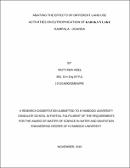Abating the effects of different land use activities on eutrophication of Kabaka’s lake Kampala - Uganda
Abstract
Various land uses resulting from urbanization in Kampala the capital city of Uganda, have reduced the natural pollutant filtration value of the wetlands. This has in turn led to a decline in the water quality and gradual eutrophication of available water bodies such as Kabaka’s lake, characterised with green colored water, foul smells, and tastes. The aim of this study was to assess eutrophication management strategies for abatement of the effects of the different land use activities on natural water quality of Kabaka’s lake. The study focused on; classification of downloaded Landsat imagery for the last 25 years, mapping of pollution hotspots and nutrient distribution with GIS, and assessment of both external (constructed wetland) and internal (dredging) eutrophication extenuation measures. Following the research showed that Kabaka’s lake catchment land use has been significantly (p<0.005) been redistributed, with buildup area increasing by 78.5%, vegetated area reducing by 37.2% and water reducing by 1.8%. This has not only significantly reduced the lakes receiving wetland footprint by 92.2% (p=0.000003) but also increased the nutrient load in the catchment mainly from; garage oil spillages, car washing bays wastewater, and sewerage. The 80,596 m2 Lake’s light attenuation is currently algae dominate, limited by nitrogen and classified under oligotrophic class of lakes (Trophic State Index<40) with a threat of eutrophication in an estimate of 25 years. Construction of a wetland in the remaining 1.34 acres of natural wetland will significant reduce Total Phosphorus by 35% and Total Nitrate by 45% (p = 0.05), whereas dredging the lake will reduce both by 80% (p = 0.0005). Watershed and proper land use management, establishment of riparian buffer vegetation and a diversion channel and community sensitization were some of the study recommendations.
Key words; Land use, Nutrient concentration, Eutrophication

